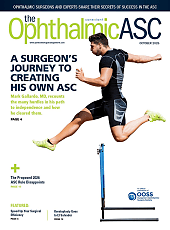The challenges of the industry and the opportunities for breakthroughs in care delivery and outcomes require a robust framework for change management. In their presentation, "Mastering the Building Blocks of Organizational Change," at the American Academy of Ophthalmology 2025 meeting in Orlando, Florida, Max Reiboldt, CPA, Chairman, Coker, and Chad Eckhardt, Partner, Frost Brown Todd, presented an outline of those core building blocks and how practices can leverage them for success.
Shifting Mindsets and Adjusting Behaviors
The first core building block of organizational change, Mr. Reiboldt and Mr. Eckhardt said, is shifting mindsets and adjusting behaviors. The first strategy, they said, is to instill ownership—articulate the “why” and how it aligns with the organization’s mission. Also, create a change in governance structure with defined roles and responsibilities, and select key leaders that champion communication of the vision and oversee execution of change initiatives. Next, they said to offer training programs that provide employees with the necessary skills and knowledge to succeed in the new environment (eg, education, technical skills, new tools/systems, revised procedures); and encourage adoption of new surgical techniques (eg, femtosecond laser-assisted cataract surgery, minimally invasive glaucoma surgeries [MIGS]), which can prevent stagnation in practice habits.
Also, they noted, open communication is essential. For example, practices can utilize surveys, focus groups, and other feedback tools to understand how employees are coping with the changes and identify areas of improvement. They also said to empower employees at all levels to be involved in decisions related to the change process. Finally, they said to embrace change. For example, invite outside-the-box thinking, request and require innovation, and consider new tools like artificial intelligence (AI).
Adapting Structure and Operational Considerations
The next core building block that was discussed was adapting structure and operational considerations. For example, redefine roles and optimize workflows to include strategic planning that defines objectives, assesses risks, and outlines an implementation strategy; and clarify and update roles to fit new strategic goals. In addition, the presenters said to carefully plan transitions from legacy workflows so that change is incremental. And finally, organizations should measure and track performance to define and track KPIs that align with the change initiative, and they should also invest in automation tools to handle repetitive tasks and reduce errors.
Legal and Regulatory Factors
Mr. Reiboldt and Mr. Eckhardt also discussed best practices for ensuring compliance. Among the advice they provided was that practices can leverage technology and automation to monitor changes effectively and establish a dedicated compliance team to assess regulatory updates. In addition, they said to maintain clear communication channels within the organization, and to develop proactive strategies to address regulatory shifts before they impact operations.
Clinical and Patient Centered Impact
Mr. Reiboldt pointed out the keys to maintaining care priorities and assessing patient outcomes. He said this includes embracing technology and innovation, such as electronic health records, telemedicine, AI and data analytics, and obtaining talent that champions digital transformation initiatives. Also important, he said, is maintaining financial sustainability.
”Because of the capital investment in lasers, etc, financial ROI is very impactful,” said Mr. Reiboldt. “Also, engaging cross-departmental teams in assessing regulatory changes fosters a comprehensive understanding of necessary operational adjustments. In addition, link investment in advanced diagnostic and surgical technologies (eg, OCT, premium IOLs, MIGS) to measurable improvements in visual outcomes and quality of life, to ensure financial sustainability supports, rather than competes with, patient care priorities.”
Also important, Mr. Reiboldt stressed, is to develop a culture of quality improvement. To do this, he said: “Establish feedback mechanisms to gather data from patients, providers, and staff. Also, prioritize the tracking of outcomes such as surgical complication rates, glaucoma progression, and patient-reported visual function, using these metrics to drive continuous enhancements in both clinical care and operational efficiency. While we are still in a mostly fee-for-service environment, proactively position towards value-based care goals.”
Connecting the Building Blocks Into a Cohesive Strategy
With the building blocks established, Mr. Reiboldt then presented the key components of a successful change management framework. This includes:
1. Industry impact and compliance—Stay ahead by understanding financial and regulatory shifts and their business implications.
2. Change strategy and execution—Develop a structured plan to identify, assess, and integrate updates efficiently.
3. Stakeholder engagement and training—Keep teams informed with proactive communication and tailored training.
4. Performance tracking and adaptation—Implement monitoring tools to evaluate progress and refine strategies over time.
5. Accountability and oversight—Strengthen governance with clear roles, responsibilities, and accountability measures.
Embracing AI
Finally, Mr. Reiboldt explained that AI could also be leveraged to address operational gaps, reduce costs, and maintain efficiency without the need for additional hiring. Below are some specific examples he provided of key challenges in practices and how AI can address those challenges:
Key Challenge: Rising Operational Costs
Financial pressures can compromise the quality of care provided to patients
How Can AI Help? By automating appointment scheduling and patient record management, AI frees up valuable time for health care professionals to focus on patient care. This not only enhances staff productivity but also improves patient satisfaction.
Key Challenge: Reimbursement Issues
Complications and delays in insurer reimbursement can lead to cash flow problems
How Can AI Help? AI can forecast patient care trends and financial performance. By leveraging data-driven insights, organizations can make informed decisions that enhance operational efficiency and financial health.
Key Challenge: Inefficiencies in Operations
Outdated processes and administrative burdens leading to increased operational expenses and resource wastage
How Can AI Help? AI-enabled telehealth platforms are transforming care delivery and expanding access to services while alleviating the burden on health care facilities. These solutions improve efficiency and patient outcomes by allowing patients to consult with health care providers remotely. OM








